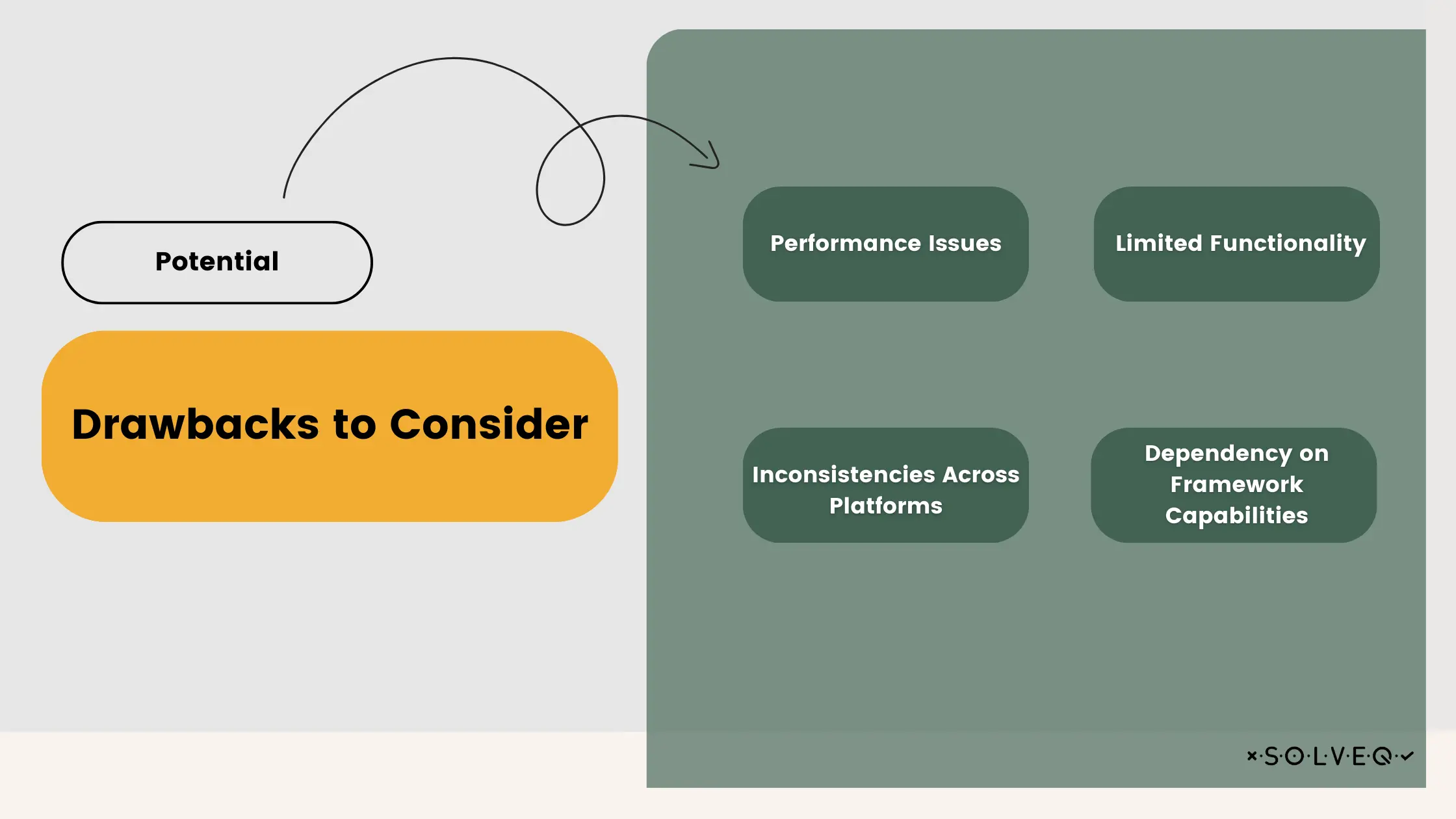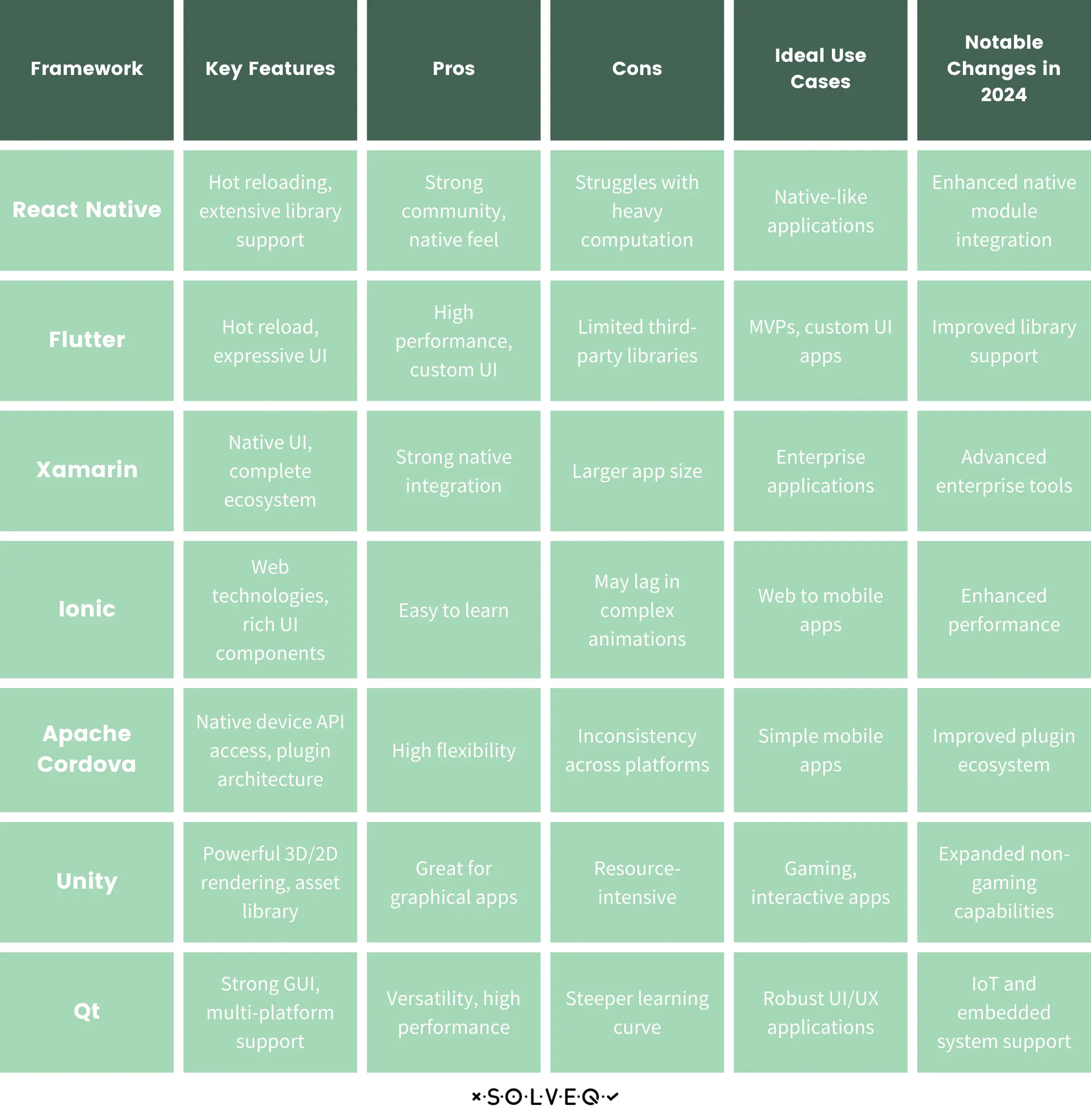Top cross-platform Frameworks in 2024: What should I choose for my app?
23 Jan 2024 • 18 min read

Marcin Kulawik

In 2024, cross-platform development stands at the forefront of the tech industry, revolutionizing how apps are created and experienced across multiple devices. This dynamic field melds efficiency with broad accessibility, making it more relevant than ever in our digitally interconnected world. The aim of this blog post is to guide you through the intricate landscape of cross-platform frameworks. We'll delve into the top frameworks of the year, analyze their evolution and capabilities, and provide insights to help you choose the right framework for your specific project needs.
What are Cross-Platform Frameworks?
In the realm of software development, cross-platform frameworks stand out as essential tools for creating versatile and efficient applications. These frameworks allow developers to write code once and deploy it across multiple operating systems like iOS, Android, and Windows. This approach not only saves time and resources but also ensures a consistent user experience across various devices.
The evolution of these frameworks up to 2024 can be outlined in distinct stages:
- Initial Phase (Pre-2010s): The early versions of cross-platform frameworks were basic, focusing mainly on compatibility across platforms. They were often limited in terms of performance and user experience, catering mostly to simpler applications.
- Expansion Era (2010s-2020): This period saw significant advancements in functionality and user interface capabilities. Frameworks began to support a wider range of features and started to offer more native-like experiences. However, there were still challenges in terms of performance and seamless integration with device-specific functionalities.
- Maturation and Optimization (2020-2024): The most recent phase marks a period of maturation and optimization. Modern frameworks now boast advanced features such as:
- Enhanced performance close to native applications.
- Improved integration with native device features and functionalities.
- Broader support for complex applications and sophisticated user interfaces.
- Focus on developer-friendly environments with improved tools and documentation.
This progression underlines the shift towards creating more sophisticated, user-centric applications that operate seamlessly across various platforms, reflecting the dynamic needs of modern users and the intricately interconnected nature of digital technology.
Why Choose a Cross-Platform App Development?
Choosing a cross-platform app development approach offers a blend of benefits that can significantly impact the efficiency and reach of your software projects. Here's why you might consider it:
Benefits of Using Cross-Platform Frameworks:

- Cost-Effectiveness: Developing one app that runs on multiple platforms dramatically reduces development costs. Instead of investing in separate native apps for each platform, you allocate resources to a single development team and a unified codebase.
- Faster Development Time: With cross-platform frameworks, the development cycle is shorter. Developers write the code once and deploy it across various platforms. This not only speeds up the development process but also facilitates quicker updates and maintenance.
- Consistent User Experience: These frameworks ensure a uniform user experience across different devices and platforms. A consistent look and feel of the app irrespective of the platform enhances user engagement and satisfaction.
- Broader Market Reach: By catering to multiple platforms simultaneously, your app can reach a wider audience. This increased market penetration is crucial for businesses aiming to establish a strong presence across diverse user bases.
- Easier Maintenance and Updates: Updating a cross-platform app is simpler since changes are made to a single source code. This streamlined process makes maintaining and updating the app more efficient.
Potential Drawbacks to Consider
However, while there are numerous advantages, it's important to also consider some potential drawbacks that come with cross-platform app development:

- Performance Issues: While modern frameworks have significantly improved, cross-platform apps may still lag behind native apps in terms of performance, especially for graphics-intensive applications.
- Limited Functionality: There might be limitations in accessing certain native features of devices or in implementing complex, platform-specific functionalities.
- Inconsistencies Across Platforms: Despite the promise of uniformity, slight variations in how different platforms render components can lead to inconsistencies in the user experience.
- Dependency on Framework Capabilities: The app's capabilities are tied to the limitations and updates of the chosen framework. Developers must adapt to changes in the framework and sometimes wait for new features to be supported.
In conclusion, cross-platform app development offers a balanced pathway between cost, efficiency, and market reach. However, it's crucial to weigh these advantages against potential performance and functionality constraints, particularly for apps with complex requirements or those requiring intensive use of native device features
Introduction to Top Cross-Platform Frameworks in 2024
Building on our exploration of the benefits and drawbacks of cross-platform app development, let's delve into the top frameworks that are shaping the industry in 2024. The frameworks we've selected meet critical criteria such as performance, ease of use, and adaptability to the latest market trends. These trends are increasingly focusing on advanced integration capabilities, exceptional performance, and delivering a near-native user experience. Next, we'll examine each of these leading frameworks in detail, evaluating their histories, key features, strengths, weaknesses, ideal use cases, and their community and support systems, along with any significant advancements they've made in 2024.
Individual Subsections for Top Frameworks
1. React Native
- Brief History and Evolution: Developed by Facebook, React Native has grown from a simple framework to a robust tool.
- Key Features and Capabilities: Hot reloading, extensive library support, strong performance.
- Pros and Cons: Excellent community support, but sometimes struggles with heavy computation.
- Ideal Use Cases: Ideal for applications that require a native look and feel.
- Community and Support: Large and active community.
- Notable Changes in 2024: Enhanced integration with native modules.
2. Flutter
- Brief History and Evolution: Developed by Google, known for its Dart programming language.
- Key Features and Capabilities: Hot reload, expressive UI, and native performance.
- Pros and Cons: High performance but limited third-party libraries.
- Ideal Use Cases: Great for MVPs and apps with custom UI.
- Community and Support: Rapidly growing community.
- Notable Changes in 2024: Improved performance and expanded library support.
3. Xamarin
- Brief History and Evolution: Acquired by Microsoft, it uses C# for cross-platform development.
- Key Features and Capabilities: Native UI, complete development ecosystem.
- Pros and Cons: Strong native integration, but larger app size.
- Ideal Use Cases: Enterprise-level applications.
- Community and Support: Backed by Microsoft, with extensive documentation.
- Notable Changes in 2024: Advanced tools for enterprise solutions.
4. Ionic
- Brief History and Evolution: Focused on building hybrid applications using web technologies.
- Key Features and Capabilities: Use of web technologies, rich set of UI components.
- Pros and Cons: Easy to learn but may lag in complex animations.
- Ideal Use Cases: Web developers transitioning to mobile apps.
- Community and Support: Strong community, good documentation.
- Notable Changes in 2024: Enhanced performance for complex applications.
5. Apache Cordova
- Brief History and Evolution: An Adobe open-source project, focusing on mobile app development using HTML, CSS, and JavaScript.
- Key Features and Capabilities: Access to native device APIs, plugin-based architecture.
- Pros and Cons: High flexibility, but sometimes inconsistent across platforms.
- Ideal Use Cases: Apps that don't require heavy native functionality.
- Community and Support: Large community, extensive plugin options.
- Notable Changes in 2024: Improved plugin ecosystem.
6. Unity
- Brief History and Evolution: Initially a game development platform, now expanded to support a wide range of cross-platform applications.
- Key Features and Capabilities: Powerful 3D and 2D rendering, extensive asset library.
- Pros and Cons: Excellent for graphical applications, but can be resource-intensive.
- Ideal Use Cases: Ideal for gaming and interactive applications.
- Community and Support: Large, dedicated community and substantial documentation.
- Notable Changes in 2024: Expanded capabilities for non-gaming apps.
7. Qt
- Brief History and Evolution: A mature framework known for its wide range of tools for building cross-platform applications.
- Key Features and Capabilities: Strong GUI capabilities, multi-platform support.
- Pros and Cons: High performance and versatility, but a steeper learning curve.
- Ideal Use Cases: Complex applications requiring robust UI/UX.
- Community and Support: Strong global community and comprehensive documentation.
- Notable Changes in 2024: Enhanced support for IoT and embedded systems.
Comparative Analysis

The Future of Cross-Platform Development
As we look beyond 2024, the landscape of cross-platform development is poised for continued innovation and transformation. Emerging trends and future predictions suggest an exciting trajectory for both new and existing frameworks.
Emerging Trends and Future Predictions:
- Artificial Intelligence and Machine Learning Integration: AI and ML are expected to play a more significant role in cross-platform development. This integration will likely bring smarter, more adaptive apps that can provide personalized experiences based on user data.
- Increased Focus on Performance and Efficiency: Future frameworks will likely emphasize even greater performance, rivaling native apps. This includes better memory management, faster load times, and optimized graphics rendering.
- Progressive Web Apps (PWAs): PWAs are set to become more prevalent in cross-platform development. They offer the advantage of traditional web apps but with the feel and functionalities of native apps. This trend might reshape the focus of cross-platform frameworks towards better integration with PWAs.
- Augmented Reality (AR) and Virtual Reality (VR): As AR and VR technologies mature, cross-platform frameworks will evolve to support these immersive experiences more fully, making it easier for developers to create AR/VR apps that are accessible across various devices.
Potential New Frameworks and Advancements in Existing Ones:
- New Frameworks on the Horizon: With the ever-growing demand for cross-platform solutions, we can anticipate the emergence of new frameworks that address current limitations and bring novel capabilities, especially in areas like AR/VR, AI, and edge computing.
- Advancements in Existing Frameworks: Current leaders like React Native, Flutter, and others are likely to undergo significant enhancements. These could include better native integration, more robust support for the latest hardware features, and tools that streamline the development process.
- Custom Hardware Support: Future frameworks may offer more extensive support for custom hardware, including IoT devices and wearables, making it easier to develop applications that interact seamlessly with a wide range of devices.
- Eco-Friendly and Sustainable Development: As sustainability becomes a global priority, frameworks that enable more energy-efficient app development might emerge, contributing to reduced digital carbon footprints.
In conclusion, the future of cross-platform development is marked by a blend of technological advancements and a growing emphasis on creating more intelligent, efficient, and immersive applications. As the digital landscape evolves, so too will the tools and technologies that drive cross-platform development, continually expanding the boundaries of what's possible in the app development space.
Choosing the Right Framework for Your Project
Selecting the appropriate cross-platform framework is crucial to the success of your app development project. The decision should be based on a careful consideration of various factors tailored to your app's unique requirements. Here are key considerations and tips for making an informed choice:
Factors to Consider:
- Target Audience: Understand the preferences and devices predominantly used by your audience. If your target market largely uses a specific platform, choose a framework that offers superior performance on that platform.
- App Functionality and Complexity: Evaluate the complexity of the app you intend to build. For apps requiring intensive graphics or advanced functionalities, opt for a framework known for high performance and native feature integration.
- Development Budget and Resources: Consider your budget constraints and the availability of skilled developers. Some frameworks may require more specialized knowledge or have higher development costs.
- Time to Market: If rapid development and deployment are critical, choose a framework with a reputation for ease of use and faster development cycles.
- Maintenance and Scalability: Consider the long-term perspective of app maintenance and scalability. Frameworks that allow easy updates and scaling will be advantageous as your app grows.
- Community and Support: A strong community and good support can be invaluable, especially for resolving issues and keeping up with new advancements.
Tips on Evaluating and Selecting a Framework:
- Research and Compare: Start with thorough research. Compare the leading frameworks based on their features, performance, and suitability for your project's needs.
- Check Documentation and Resources: Well-documented frameworks with extensive learning resources can significantly ease the development process.
- Consider Existing Case Studies or Portfolios: Look at existing applications built with the frameworks. Analyzing these can provide insights into their real-world performance and capabilities.
- Test with Prototypes: If possible, create simple prototypes with the shortlisted frameworks. This hands-on approach can help you gauge their ease of use and compatibility with your project requirements.
- Seek Community and Expert Opinions: Engage with developer communities or consult with experts. Their experiences and insights can provide valuable perspectives that might not be apparent from just technical documentation.
- Future-Proofing: Consider the future trajectory of the framework. A framework that is actively maintained and updated is more likely to keep up with technological advancements and remain relevant.
In conclusion, choosing the right cross-platform framework involves a balance of understanding your specific project needs, thorough research, and a bit of forward-thinking. By carefully considering these factors and tips, you can select a framework that not only meets your current requirements but also supports the future growth and evolution of your app.
Summary
In 2024, cross-platform development has become a pivotal aspect of the tech industry, offering a unified approach to app creation across various devices. This article delves into the realm of cross-platform frameworks, highlighting their evolution, benefits, and challenges. It meticulously evaluates top frameworks like React Native, Flutter, Xamarin, and others, considering their features, pros and cons, and suitability for different project needs. The piece also forecasts future trends in cross-platform development and provides practical guidance for selecting the right framework for specific projects. Conclusively, it's an essential read for developers and businesses aiming to make informed decisions in the rapidly evolving landscape of app development.
Share:
Looking for expert development team?
Schedule a call with Tech Consultant

Marcin Kulawik
Founder and CEO of SolveQ. Huge fan of building things with purpose, agility, and having fun while changing the World. Loves his family, teammates, and nature.